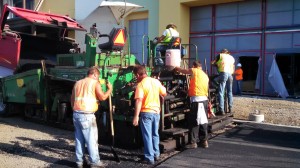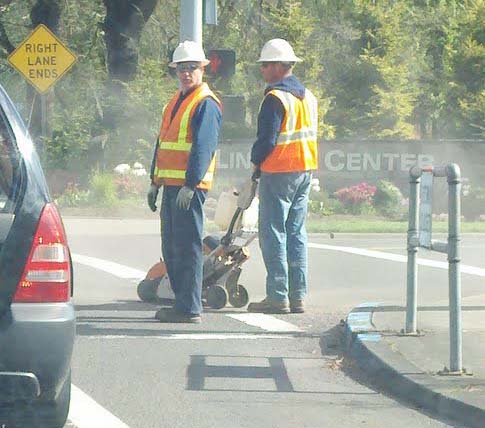Entries tagged with “asphalt”.
Did you find what you wanted?
Wed 9 Jul 2014
Posted by admin under Air Monitoring, Asphalt, Carcinogen, Chemical Exposure, CTPV, Dermal, Engineering Controls, Exposure, Hazard Communication, occupational hygiene, odor thresholds, OSHA, Radiation, Respirators, Training, Uncategorized
Comments Off on Working with Coal Tar Pitch (volatiles)
It is officially summer and construction road crews & roofing is in full swing. Some projects require the use and application of coal tar pitch. Not only is it stinky, it is is hazardous.
Here’s some info:
- Uses
- Roofing
- Asphalt seal coating
- Pharmaceutical treatment for psoriasis (scalp/skin condition)
- Graphite industry (in the production of graphite)
- General
- Coal tar pitch is actually a make-up of a bunch of different substances (maybe even 10,000 of them)
- Contains lots of polycyclic aromatic hydrocarbons (PAHs) and other chemicals including: benzene, pyrene, benzo(a)pyrene, phenanthrene, anthracene
- Exposure
- can be exposed by inhalation, ingestion (is this likely?), or exposure to skin, eyes
- considered a carcinogen if the product contains more than 5% of coal tar
- cancers include: skin, scrotal, lungs, bladder, kidney & digestive
- increases your sensitivity to sunlight (easier to sunburn)
- Safety
- Pick a sealant/coating that does not contain coal tar. A list of some can be found here.
- Avoid inhalation & skin/eye contact
- Train your employees. A sample safety SDS (MSDS) can be found here.
- Wear the correct PPE.
- Air sample to determine exposures. OSHA has a method (58).
- Resources

Mon 17 Sep 2012
Posted by admin under Air Monitoring, Asphalt, Silica
Comments Off on Silica in asphalt

For people who work with asphalt everyday, this may be a obvious statement: Silica is in asphalt.
There are two areas where this might be of concern:
- During the mixing of the asphalt there is usually some ratio of rocks that are added to the product. The size of these rocks is where safety personnel should have concerns. If they are adding the smallest fraction of rock to the mix, you may have airborne exposures to silica. This size of rock is called P200 (or, using a 200 sieve screen to get anything less than 200 parts per inch). Usually this is seen during the transfer of rock from the loader or from the belt conveyor.
- The other method of exposure to silica in asphalt is if you cut it. Rocks may contain silica. When asphalt is cut, you incidentally cut through various rocks (contained within the asphalt). Silica (and dust) is released during the cutting. Please use water when you are cutting asphalt. Direct the water at the blade.

Thu 28 Jun 2012
Posted by admin under Concrete, Engineering Controls, GHS, Hazard Communication, industrial hygienist, Lead, Management, MSDS, Silica, Training, ventilation
Comments Off on IH Camp – summary
The big industrial hygiene conference (AIHCe) is held in a different city each year. This year was Indy, Indiana. Below is my personal top ten list  of “lessons learned” from last week.
- IH’s need to do a better job of sharing. We don’t share data, experiences, information, knowledge or our ideas well.
- CPWR is trying to share. Center for Construction Research & Training. Â I’m looking forward to seeing their published independent review of local exhaust ventilation (LEV) units.
- The minimum exhaust rate for a portable exhaust unit must be 106 cfm (cubic feet per min) to capture particulates (dust, silica) during tuckpointing with a 5 in grinder (but it’s also a good rule of thumb).
- Asphalt milling machines are still a huge silica problem. Water controls are NOT enough. You need a local exhaust system too. (here’s an earlier post I made on it)
- GHS Safety Data Sheets – it’s not as complicated as you think. There are some significant changes, but don’t worry, OSHA’s here to help (ha). Seriously, more information will be available soon.
- Ignite. Have you seen these before? Short, stand up speeches about their ideas/passions. Similar to TED. Some were better than others. But, did I mention they were short?
- Committees. Be careful when you open your mouth. My idea was so great, they are making me do it.
- Â ANSI A10.49! A health standard for construction. Great idea, but lots of work.
- Check out Environment for Children. I don’t know much about it, but they have a great mission.  Believe me, in the US, we’re WAY ahead.
- Presentation. It’s all up to you to make it. I will not cast blame on those who had bad presentations. BUT, it reminds me that I should work on this skill. Even if you have something good to say, if you give a horrible presentation, it’s likely no one will notice. On the other side, if your presentation is good, people will listen, even if you’re talking about nothing! Â My favorite of the week: Dr. Mike Morgan (Univ. of Washington) on Chromium VI. He was very factual, not too flashy, and make the point without needless details.

Thu 10 May 2012
In  the trainings I perform for employers, I try to explain to them that there IS overexposure to silica on their jobsite. I tell them that if I could be at their site everyday, and be ready to perform air monitoring at a moments notice, I could find overexposures.
Here is an example of a road crew cutting asphalt with a concrete saw. I’m sure it was a small cut (since they were not a concrete cutting subcontractor, and it was a tiny little saw). But the haze you see is the dust plume from the cutting.
I just happened to drive by and be stopped at a red light when this occurred. I know, I probably shouldn’t have touched my phone (while in my car) to take a picture…but I couldn’t resist. And, with that same train of thought, the road construction crew probably thought, “it’s just a small cut and it will only take 5 minutes”. So, neither of us are innocent
 .
.





